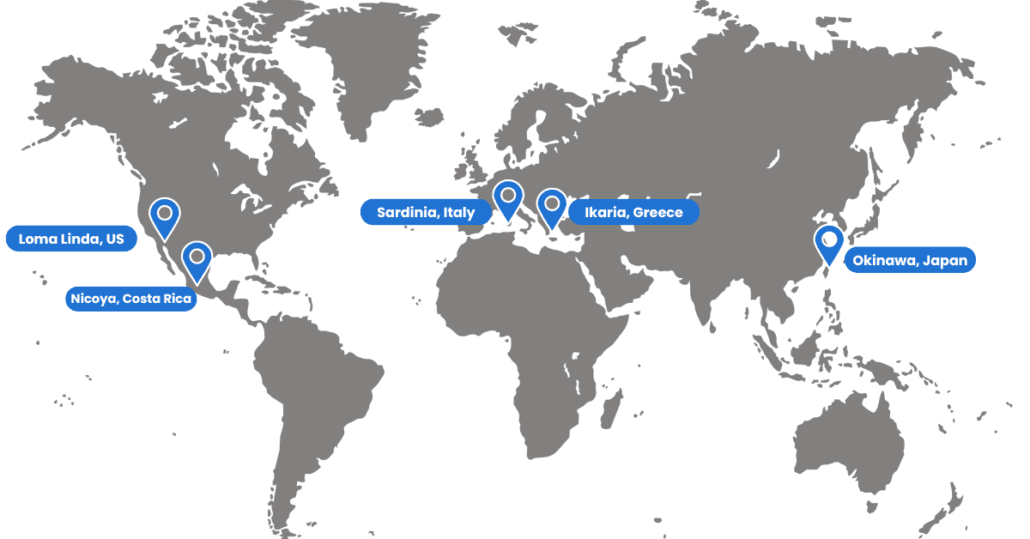Why The Blue Zones’ Secrets Might be the Key to a healthy and happy Workplace
“Blue Zone” is a non-scientific term given to geographic regions that are home to some of the world’s oldest people.
It was first used by the author Dan Buettner, who was studying areas of the world in which people live exceptionally long lives.
They are called Blue Zones because when Buettner and his colleagues were searching for these areas, they drew blue circles around them on a map.
There are currently 5 areas in the world that are recognised as blue zones

- Ikaria, Greece
- Ogliastra, Sardinia, Italy
- Okinawa, Japan
- Nicoya, Costa Rica
- Loma Linda, California, US
Long-term benefits that a Blue Zones life can help you achieve:
- To live a longer, better life
- To have more energy, feel stronger, and gain health
- To have better sleep and feel rested every day
- To meet new people and nurture supportive relationships
- To discover your purpose and put it to work
- To be a change agent to help better your community
Although the residents in blue zones live in very different parts of the world, they have 9 commonalities that lead to longer, healthier, happier lives.
- Move naturally – This is the idea that exercise in nature and activities like gardening without machinal devices if the best form of exercise.
- Have a purpose – Having a sense of purpose is worth up to 7 years extra life expectancy. Having a purpose to get up in the morning helps your life having meaning
- Downshift – When people in blue zones experience stress, they have routines to shed that stress. Okinawans take a few moments each day to remember their ancestors, Adventists pray and Ikarians take a nap and Sardinians do happy hour.
- 80% rule – This is the idea that you eat until you’re 80% full, which can be the difference between gaining and losing weight. People in blue zones also eat meals late afternoon or early evening, then they don’t eat any more for the rest of the day.
- Eating lots of plants – Meat is eaten a lot less frequently, their diet consists mostly of vegetables, legumes, whole grains and nuts.
- Moderate alcohol consumption – People in blue zones (Except Adventists in Loma Linda) drink alcohol moderately and regularly. For example, Sardinian drink 1-2 glasses per day – Sardinian Cannonau Wine, which contains 3 times the amount of anti-oxidants compared to other wines.
- Belong – Most centenarians belong to some faith-based community. Research shows that attending faith based services four times per month will add 4-14 years of life expectancy.
- Putting your loved ones first – Centenarians in the blue zones put their families first, and keep their aging parents and grandparents nearby or in the home. They commit to a life partner and invest in their children with time and love.
- Right people around you – The world’s longest lived people chose or were born into social circle that supported healthy behaviours.
How can you use these 9 commonalities to make a healthy workplace?
These principles from the Blue Zones can be adapted to the workplace to promote a longer, healthier life. Here’s how you can integrate them in your workplace:
Walking
Go for walks in your lunchbreak or maybe create a walking group at work – https://www.riskex.co.uk/lunchtime-walking-clubs
Having a purpose at work
Make a list of things that matter the most to you and then see if you work values align with the company’s values. Having a job that you feel is important. Feeling like you are achieving your career goals is the key to a successful professional career.
Ways to destress from work
When you are experiencing stress at work, find ways to destress. This could be:
- Going for a walk or do some exercise in your lunchbreak or after work. Perhaps encourage more walking meetings. Take the stairs instead of the lift. Organise outdoor team building exercises.
- Practice mindfulness and meditation before or after work
- Find hobbies outside of your job that you enjoy and calm your mind
Other ways you could de-stress at work
- Organise your workspace – Tidy desk, tidy mind. This can help you feel more in control and less stressed.
- Stretches – Simple stretches can relieve muscle tension and improve blood flow.
- Take short breaks – Regular breaks can help you stay focused whilst reducing burnout.
- Talking to colleagues – Sharing your thoughts with colleagues can be very relieving.
- Practice deep breathing – Focusing on your breathing and inhaling deeply and exhaling slowly can calm your mind.
Promote healthy eating
Encourage more healthy eating by providing access to fruits, vegetables and nuts. Promote a culture where employees take time to enjoy their meals rather than eating at their desks can contribute a healthy workplace.
Putting your loves ones first
Promote a work-life balance by offering flexible hours and remote working options. Encourage employees to prioritise family time and personal well-being.
Create and be a part of a supportive work environment
Foster a sense of community within your workplace. Encourage participation in team activities, celebrate achievements and milestone together and support each other personally and professionally.
In conclusion, integrating the principles from the Blue Zones into your workplace can significantly enhance the well-being and longevity of you and your staff and create an environment that promotes health and happiness, and could be the key to a healthy workplace.
Taking even one of these steps can lead to a more fulfilling life. Why not try it?
If you want to find out more about the blue zones, try watching “Live to 100: Secrets of the Blue Zones” on Netflix
Sources






